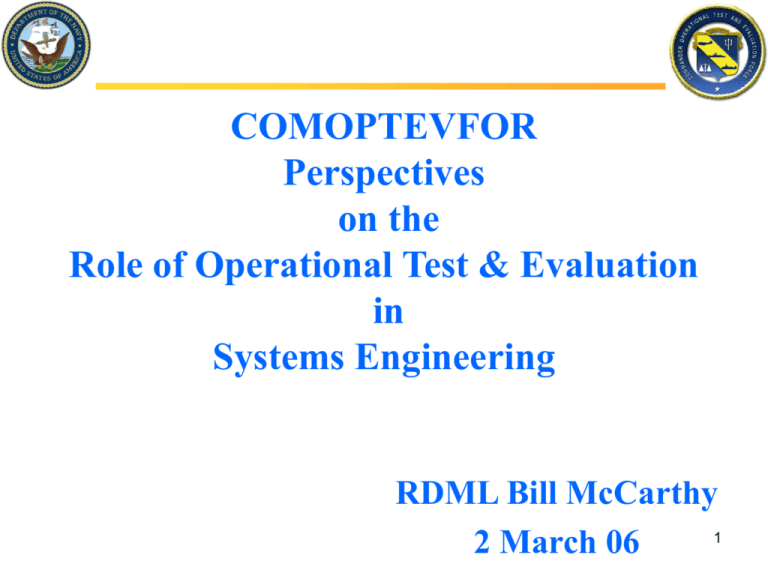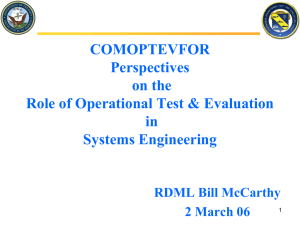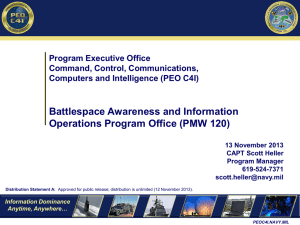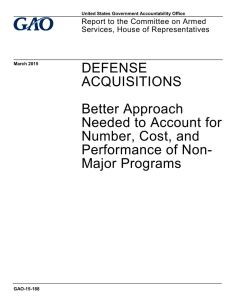COMOPTEVFOR Perspectives on the Role of Operational Test
advertisement

COMOPTEVFOR Perspectives on the Role of Operational Test & Evaluation in Systems Engineering RDML Bill McCarthy 1 2 March 06 Topics •The Role of Test and Evaluation •Current Trends in Navy Operational Test •Integration of Testing (DT/OT) •Enterprise Solutions • Need for Modeling & Simulation • Policy Considerations • Challenges – Myths and Money • The Way Ahead – again! 2 Defense Acquisition Performance Assessment • “Systems engineering capability within the Department is not sufficient to develop joint architectures and interfaces, to clearly define the interdependencies of program activities, and to manage large scale integration efforts.” • “…a “Conspiracy of Hope” in which we understate cost, risk, and technical readiness and, as a result, embark on programs that are not executable within initial estimates.” 3 The Role of Test & Evaluation • T&E is an engineering discipline that has responsibility for informing system developers and decision makers whether the system in question meets the requirements for which it is being built. • There are a vast number of activities that fall under the broad category of T&E. • This presentation focuses on those efforts associated with traditional acquisition programs: – Contractor testing – Developmental testing – Operational testing 4 The Role of Test & Evaluation • Contractor testing – those efforts undertaken by the system builder to assure that the system being built will meet contractual specifications. – Often encompasses specific demonstrations which must be accomplished in the presence of government witnesses. • Developmental testing – objectives designed by the Program Manager and performed by specified organizations (generally governmental) to identify technical capabilities and limitations of alternative concepts and to assess the technical progress and maturity against the critical technical parameters. Traditionally, assesses whether the system under test will conform to contractual specifications. – NAWC, VX squadrons, NUSWC, NSWC etc. • Operational testing – objectives designed by the Operational Test Agency and performed by representative operational personnel to determine whether the system under test is operationally effective and operationally suitable. – COTF, VX squadrons, trusted agents, etc. 5 Special Considerations concerning Operational Test & Evaluation • Operational Test Agencies – Charged by statute (10USC2399) to provide an independent operational evaluation of programs of record to service chief. – Chartered to determine the Operational Effectiveness and Operational Suitability of systems undergoing Initial Operational Test & Evaluation (OPEVAL). – Report is sent to the Service Chief and the Director, Operational Test and Evaluation. The latter makes an independent assessment and provides an annual report to the Congress • DODI 5000.2 states “OT&E shall determine operational effectiveness and suitability of a system under realistic operational conditions, including combat; determine if thresholds in the approved CPD and critical operational issues have been satisfied; and assess impacts to combat operations.” 6 Operational Effectiveness The capability of a system to perform its mission in the fleet environment, and in the face of the expected 7 threat, including countermeasures. Operational Suitability Reliability Maintainability Availability Documentation Logistic Support Training Compatibility The capability of a system, when operated and maintained by typical fleet personnel in the expected number and of the expected experience level, to be supportable when 8 deployed, compatible and interoperable... Requirements for OT&E • The magnitude of the weapon system acquisition program determines whether OT&E is required, and who determines adequacy of OT&E scope ACAT IV M and AAP ACAT IV T ACAT III Programs below ACAT II cost which involve combat capability Operational Test required by instruction No operational test required ACAT II Programs $140M RDT&E Or $660M Procurement ACAT I Programs $365M RDT&E Or $2.190 Procurement Operational Test required by USC Title X before FRP COMOPTEVFOR approves test plan and funding, and determines Title X: DOT&E approves the number of test articles test plan and funding, and determines number of test articles Any program, regardless of ACAT level, on the OSD OT&E oversight list requires OT&E and requires DOT&E approval of test plans and funding 9 The Role of the OTA • Each service implements somewhat differently. • Department of the Navy – Operational Test & Evaluation Force – Marine Corps Operational Test & Evaluation Agency • Department of the Army – Army Test & Evaluation Command (dual hatted as OTA) • Department of the Air Force – Air Force Operational Test & Evaluation Command (Initial OT&E only) 10 OT&E Customers • Some of the principal taskers and users of COMOPTEVFOR operational test and evaluation – CNO, Law, Milestone Decision Authorities (USD AT&L, ASN RD&A, PEOs & SYSCOMs), DOT&E Users CNO Sets Operational Requirements OSD-DOT&E Oversees ACAT I & selected other acquisitions Milestone Decision Authority Tasks OAs in Acq. Decision Memos USC Title X Requires OPEVALs for ACAT I & II acquisitions Operational test and evaluation executed by COMOPTEVFOR Taskers OT reports support deployment decisions CNO OT results to support BLRIP reports OSD – DOT&E OT reports to support procurement decisions Milestone Decision Authority OTDs support fleet introduction Fleet Users 11 Types of Operational Testing • Early Operational Assessments • Operational Assessments • Initial Operational Test & Evaluation (IOT&E) – Also referred to as OPEVAL • Follow-on Operational Test & Evaluation (FOT&E) 12 Phases of OT&E • Phases of operational test are determined by progress of a program through the acquisition phases – There are also special phases of OT – Quick Reaction Assessments (QRAs) & Verification of Correction of Deficiencies (VCDs) - not tied to the acquisition process A B (Program Initiation) C IOC FOC (Initial Operational Cap.) (Full Operational Cap.) Experiments and technology demos ACTDs, ATDs, FBEs System Development Production & Deployment & Demonstration Concept & Technology Development Critical FRP LRIP Design Review (Early Operational Assess.) (Full-rate prod.) Decision Systems Acquisition Pre-Systems Acquisition EOA (Low-rate initial production) Operations & Support Sustainment OA (Operational Assessment) OPEVAL FOT&E Studies and Analysis Modeling and Simulation Modeling and Simulation Prototype Articles (Follow-on OT&E) Production Representative Articles 13 Early Operational Involvement • Specific examples from DD(X): – Long Range Land Attack Projectile fusing – identified the need for a point detonation fuse – Nitrogen servicing requirements – identified need for N2 system (vice 4 service bottles) to support MH-60 tire, strut, rotor head and sonobuoy launcher requirements – Need for shaft brakes and shaft locks identified – Additional spaces for inclusion in Collective Protection System (Secondary Ship Mission Center) were identified 14 The Challenge Increasingly complex systems •Software •Communication Feeds •Intel Dependent •Interoperability •Technology/Materials More difficult to develop More difficult to test Compressed timelines 15 Current Trends • Integration of Test and Evaluation – Fundamental concept is to minimize the duplication of effort by identifying common data requirements up front. • Re-structured MV-22 Program is an example – Ongoing effort, formalized in mid-2005 with the development of an Integrated Test Framework • Common test, shared data, independent analysis • Reduce cycle time and cost for testing while providing earlier operational input – Independent OPEVAL is retained to ensure statutory independence of the Operational Test Agency; however, the scope of the OPEVAL can be reduced to the extent that valid data are collected from integrated test. 16 Integrated Test MS A MS B Traditional Test Program MS C FRP Contractor Test Gov’t DT OA OPEVAL TECHEVAL Integrated Test Program MS A MS B INTEGRATED TEST PLAN DEVELOPMENT MS C FRP INTEGRATED TEST OPEVAL INTERIM ASSESSMENT REPORTS Schedule Reduction 17 Current Trends • Enterprise Approaches to Test & Evaluation – Should really be titled Enterprise Approaches to Systems Engineering • Logical consequence of Family of Systems development – Ship’s Self-Defense System is proto-typical example • CVN-76/LPD-17/LHA-6/DD(X)/CVN-78 – Metric for AAW assessment is Probability of Raid Annihilation – LHA-6 test program provided the forcing function – Individual testing of the full combat system by each platform would have been prohibitively expensive – No single program could bear the cost of a Self-Defense Test Ship 18 Current Trends • Alternative approach – realigned development and testing program under PEO IWS – By combining test objectives across platforms, conservative estimate is a $200M reduction in missile and target costs – Self-Defense Test Ship will allow the acquisition of data to populate the models needed to assess PRA. • Additional benefits anticipated from increased information sharing across participating platforms 19 An Enterprise Approach to AAW Self-Defense FY 06/07 RAM Lead Ship LPD 17 SPQ 9B SPS 48 SSDS MK 2 CEC FY 08/09 FY 10/11 FY 11/12 RAM ESSM RAM P3I/ ESSM CVN 76/ LHD 7/8 LHA 6 SPQ 9B SPS 49 MK 9TI SSDS MK 2 SPQ 9B SPS 49 SPS 48E SEWIP CEC SSDS OACE CVN 68 FY 12/13 FY 14/15 FY 15/16 RAM P3I/ ESSM ESSM DD(X) CVN 21 DBR TSCE DBR TSCE** Lead Ship SDTS First Test of This Integrated System RAM LCS 1 Derivative of Tested Articles LCS 2 RAM SDTS LPD 17 (CVN/LHD) SPQ 9B SPS 49* MK 9TI* SSDS MK 2 RAM SEARAM LCS 1 LCS 2 RADAR C2 SYSTEM RAM P3I/ ESSM LHA 6 (CVN, LPD, LHD) SPQ 9B SPS 49 SPS 48E? SEWIP SSDS OACE ESSM RAM P3I/ ESSM DD(X) CVN 21 MFR TSCE MFR TSCE** P RA Testbed Verification, Validation & Accreditation * CVN Only ? Test Results apply to other SSDS Variants ** Core TSCE functionality with additional applications 20 Need for Modeling & Simulation in Operational Test and Evaluation • 21st Century warfare systems are required to operate in complex environments that are difficult to assess – AAW performance assessment • Need to assess multiple hard and soft-kill systems working together – Electronic Warfare systems • Realistic pulse densities; unique threat emitters – Undersea Warfare systems • Multiple environmental conditions; realistic targets 21 Need for Modeling & Simulation in Operational Test and Evaluation • Put another way, anything short of actual use in combat is to a greater or lesser extent a form of modeling or simulation. • We have neither the time nor the money to build large numbers of threat replicators necessary to test the performance of a systems of systems in the diverse environmental conditions that may be encountered. • The challenge is to find the right mix of M&S and live end-to-end testing to ensure that weapon systems will perform as predicted in actual combat. 22 23 24 Policy Considerations • DODD 5000.1 – “The conduct of test and evaluation, integrated with modeling and simulation, shall facilitate learning, assess technology maturity and interoperability, facilitate integration into fielded forces, and confirm performance against documented capability needs and adversary capabilities…” (E1.11) • DODI 5000.2 – – “The T&E strategy shall provide information about risk and risk mitigation, provide empirical data to validate models and simulations, evaluate technical performance and system maturity, and determine whether systems are operationally effective, suitable, and survivable against the threat in the System Threat Assessment.” (E5.1.1) – “Appropriate use of accredited models and simulation shall support DT&E, IOT&E, and LFT&E.” (E5.1.4.7) 25 Policy Considerations • SECNAVINST 5000.2C – “…M&S may be used during T&E of an ACAT program to represent conceptual systems that do not exist and existing systems that cannot be subjected to actual environments because of safety requirements or the limitations of resources and facilities. M&S applications include hardware/software/operator-in-the-loop simulators, land-based test facilities, threat system simulators, C4I systems integration environments/facilities, and other simulations as needed. M&S shall not replace the need for OT&E and will not be the primary evaluation methodology. M&S shall not be the only method of meeting independent OT&E for beyond low rate initial production (BLRIP) decisions per USC 2399. M&S is a valid T&E tool…” (5.4.7.9) 26 M&S Challenges – Myths and Money • Perceptions – M&S is an inexpensive substitute for testing. – M&S is the natural extension of the computer gaming phenomenon. – M&S will revolutionize acquisition. • Facts – M&S can provide information about system performance under a variety of conditions that can not be practically assessed with live testing. – Development of models is a complex engineering task. Models and simulations vary greatly based upon their purpose. – M&S is an essential component in evolutionary acquisition. 27 The Way Ahead – Again! • There are few, if any, new ideas needed to make M&S a more effective tool. – In the last 8 years there have been a variety of studies, the need is not for study but implementation. • M&S has played a critical role in the development and operational testing of EW systems for decades. – We need to learn from this experience and use the right type of M&S where it best fits. – Successful use requires a rigorous understanding what the particular form of M&S can bring to the program. 28 The Way Ahead – Again! • M&S must be addressed in the T&E Strategy and the TEMP. – The integrated test team needs to determine where various M&S tools are best suited for use. – M&S needs to be understood as a tool set, with a variety of different tools, each suited for different applications. • Program managers must make timely investments to develop the models and collect the data necessary for viable M&S tools. – Even when modeling is used, too many programs reach the completion of DT&E without completing the verification and validation of the models used. • Enterprise solutions require Enterprise level investments in appropriate tools, such as the Self-Defense Test Ship. – Without an Enterprise approach, M&S tools are not likely to be available in time to support key acquisition decisions for “systems of systems”. • Current policies clearly support the use of M&S throughout the entire test and evaluation. 29 The Result: Integrated T & E Weather Obscurants & Interferents Chem/Bio Agent Virtual Features Individual & Collective Protection & Survivability Virtual Range Test & Evaluation Framework Effectiveness Suitability Informational Assessment Tactics I NT Live Fire Modeling and Simulation EG RA TE Informational Assessment D S Decisional Assessment OPEVAL T&E CONTINUUM T R DT / OT A T E G Y System with understood capabilities & limitations delivered to the warfighter at reduced cost! 30 Bottom Line • Rather than new policy, we need to enforce a disciplined systems engineering approach that holds developers accountable for using all available tools to best understand the capabilities and limitations of the weapon system being developed for the warfighter. 31 Questions? 32







